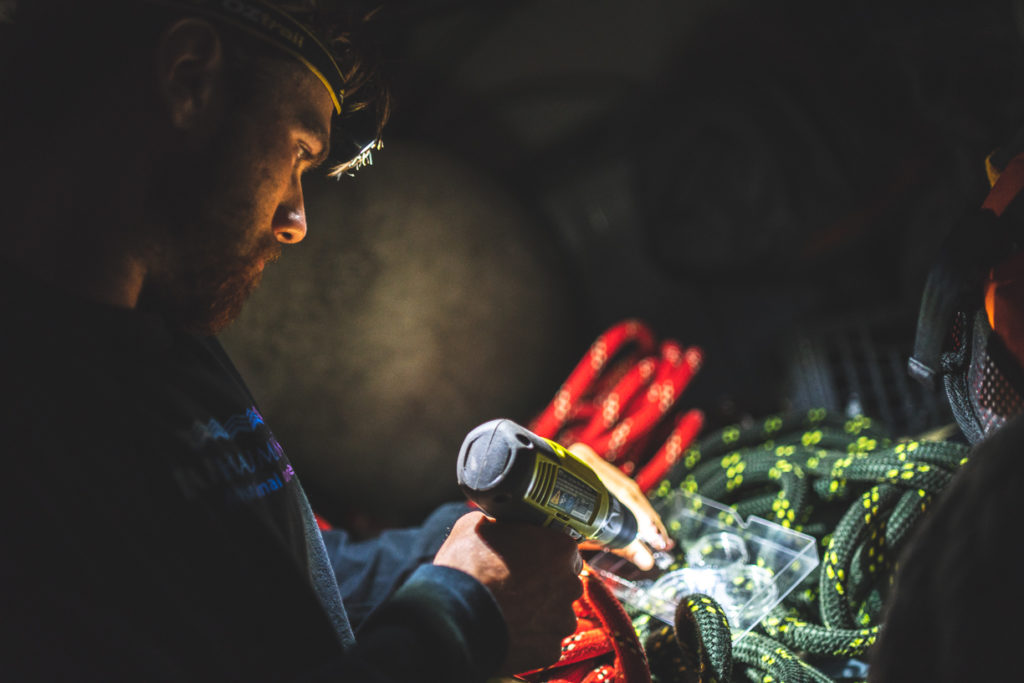Today is a big day for science! A very exciting one indeed. We are tracking Drifter D and will begin hunting at first light.
My watch started at 0400 HST (or 1400 UTC). Half asleep, I put my headlamp on and rolled out of my top bunk. I climb the stairs out of the cabin and onto the deck. Its quiet, dark, the moon is shining to the west, a weaning crescent, the stars are bright as can be, no light pollution out here, the air is moist and salty and fresh. Slightly more awake, I head back down to the nav desk and start checking emails for the drifter location. Our collaborators from University of Hawaii are sending us Drifter D coordinates every 15 minutes. I import the most recent location into our navigation software, 15 nautical miles away to the ENE.
I open up the protocol binder provided by the Smithsonian Environmental Research Center and review the retrieval and replacement protocol. We are contributing to the Floating Ocean Ecosystem (F.O.E.) Tracker study from the Smithsonian’s Marine Invasions Research Laboratory. This is a fascinating study to conceptualize because is acknowledges the reality that we humans have created an artificial ecosystem in the middle of the pacific ocean, a region that may be comparable to a desert on land, with minimal primary productivity and thus less food available to support sea life, compared to nutrient rich regions of the ocean. As exciting as this may sound to ‘create’ a new ecosystem, the effects of this artificial environment are unknown and this is why it is very important for science to study this phenomenon. One concern is that drifting debris can serve as transport vessels or micro-ecosystems that allow organisms from one side of the Pacific Ocean to migrate to the other, which has the potential to pose invasive threats to native species. For example algae from Japan could settle on a plastic fishing float debris and make its way into the Puget Sound, Washington, and compete with endemic Nereocystis luetkeana (Bull Kelp). Or little crustaceans from the Baja peninsula could wash ashore in Hawaii and naturalize. Hypothetically… Marine debris is allowing organisms to expand their ecological range.
The Floating Ocean Ecosystem Tracker study consists of several drifters and trackers deployed around the North Pacific Subtropical Gyre (Great Pacific Garbage Patch) with GPS transmitters that transmit coordinates on a programmed interval, the frequency can be increased from normal once a week to every 15 minutes as we approach. Each drifter has a drogue (sea anchor) set at different depths attached to a surface buoy with a stainless steel cable. The varying depths of the drogue allows physical oceanographers to understand ocean currents at different depths in the gyre. Biological panels are attached at different depths on the cable to study the types of organisms present in the gyre at different depths. Researchers from the Smithsonian and University of Hawaii have provided us with 9 new drifter replacement bio-panels, and 5 new trackers with bio-panels to attach to large debris items we find in the gyre. We will collect the old panel for analysis by photographing it in the water, then cutting it off the drifter cable, then photographing it above the water, storing it in a plastic bag (can’t escape the plastic), replacing the panel with a new settlement panel, then preserving the sample in the freezer until we can ship it to the Smithsonian back on land. We are using high resolution photography as a scientific tool to document our procedures, the condition of the panel and life on the samples.
It is exciting to be contributing to such a fascinating and significant study. But, when I expand my perspective to a holistic view of this plastic pollution issue it is disheartening and disturbing. I find it hard to just accept and be okay with the fact that we are altering our oceans globally with plastics that never decompose and be blind to the consequences of this reality. I have more to ramble on this topic, but that will come in future blog posts, stay tuned.
I leave you with a question that is on my mind: Are you OKAY with accepting the reality that you are likely ingesting microplastics everyday unintentionally and unknowingly? Please leave your comments!
27°53 N / 153°51 W
Drew – Scientist
Follow our progress with our live tracker
More updates on instagram, facebook and twitter
Photo credits @osleston




3 thoughts on “[DAY 12] The Hitchhiker’s Guide to the Pacific Ocean”-
-
-
I would like to know what the potential risks are of having microplastics in our bodies. Are there any studies in place to determine the long (or short-term) impact of this? And what disease could it be contributing to? Great article! Super interesting! Thank you Drew!
Great read from your first cousin twice removed! Your Grandpa Norm is my first cousin.
Absolutely not. Thank you for all the efforts that you and the team are doing. Can’t do much in my little part of the world to help you all except be mindful of my own plastic use and pray and that I do for all of you.
All the best!